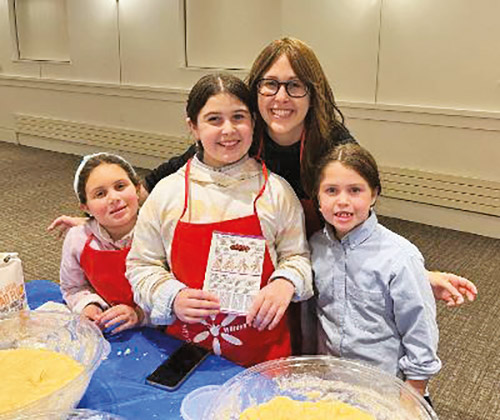
Shabbat Project events took place this year in Jewish communities across the globe coinciding with Parshat Vayeira. Across the planet, more than 1 million people in many Jewish communities took part in the Shabbat Project’s 10th anniversary.
On November 10, the Young Israel of New Rochelle (YINR), along with many other local synagogues held their annual Shabbat Project challah bakes. From young to old, 70 YINR women and girls lined the social hall in their bright red aprons. In front of them was Rebbetzin Yael Axelrod’s famous challah dough recipe, with pre-measured ingredients waiting to be assembled for baking. Axelrod walked the ladies through the recipe, noting important steps: not to add the eggs until the hot water has been absorbed and to add the flour in small amounts at a time. The Women’s League also presented each baker with a decorative challah dough cover for use while the dough rises.
At previous Shabbat Project events, Rebbetzin Abby Fink presented the history of this baking project, and the symbolism of challah’s ingredients. This year, she discussed halachas of challah.

“We enjoy serving challah, we doubly enjoy eating challah,” she said. “There’s a mitzvah associated with Shabbat, specifically for challah to be eaten at a seuda. On Friday night, I believe we all do have that seuda.
“However, sometimes on Shabbos afternoon. we’re not as aware,” Fink continued. “We’re in a rush, we’re running after our children, we’re on a diet, whatever the reason may be. People do go to the kiddush and they do eat, but they don’t always wash. It’s a separate and large mitzvah that we’re supposed to actually be at a seuda, an actual meal, and a meal is based on bread, in this case, our challah.” Fink explained that there is a pasuk in Tehilim that shows us a seuda is led with bread. “Even if you go to a kiddush, come home, wash and have a meal.”
The second law Fink discussed was the concept of Lechem Mishnah. She reminded the group we have two lechems, because in the days of the midbar (desert), a double portion of manna always came down on Friday. People had no fruits, vegetables or bread. The manna tasted like everything they wanted it to taste like. It was a double portion on Friday, for Friday and for Shabbat, so they would know that they were not being neglected. We are reminded of this on our Shabbos table when we have two challahs.
The third halacha Fink discussed was the technicalities of washing one’s hands before Hamotzi and eating bread. “When we wash, we take the washing cup, we fill it with water holding it in our right hand,” she said. “Doesn’t matter if you are a lefty or a righty; we fill up the cup and hold it in our right hand. We pour the water either once or twice over our right hand. Then we hold the cup in our right hand and we pour the water either once or twice over our left hand.”

Axelrod then asked the younger bakers, “Why do we bake challah for Shabbos?” She explained that by making challah we are also doing the mitzvahs of saying the bracha and taking the dough. “We wrap the dough in two pieces of foil. We wrap twice, as this mitzvah is very important. We would give it respect with not just one piece of foil, but two.” Axelrod noted this mitzvah was “specifically given to Jewish girls. It is also a very special time to daven to Hashem.”
During the event the YINR women and girls braided their challahs from the challah dough they had just prepared, and then took their challahs to their homes for baking, to be enjoyed on Shabbos.
This movement towards uniting Jews around the magic of Shabbat was founded by South Africa’s Chief Rabbi Dr. Warren Goldstein.
“Now, with the pandemic finally behind us, this year’s Shabbat Project is going to be the biggest yet,” he said, “There’s a real thirst for in-person events and real human connection, to re-energize and reconnect. After the very divisive elections in Israel and the United States, this is an opportunity to harness the healing power of Shabbat to unify and inspire Jewish communities. In times of rising antisemitism, we need to define ourselves by our values and not by the hatred of others.”














